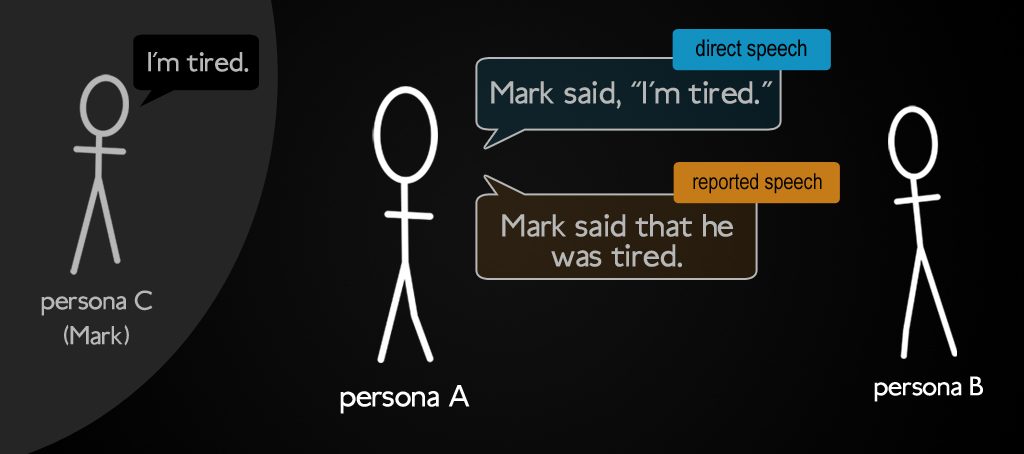DIRECT SPEECH y REPORTED SPEECH
Direct speech y reported speech tienen que ver con los hechos que relatamos.
En direct speech relatamos exactamente lo que dijo Persona C a Persona B
En reported speech, relatamos lo que dijo Persona C a Persona B usando nuestras palabras.

Tenemos una serie completa donde hablamos de direct speech, reported speech, verbos de relato y más:
- La Diferencia entre Direct y Reported Speech
- ¿Que son Los Reporting Verbs?
- Reported Speech: Más sobre Backshift
GERUNDIOS E INFINITIVOS
¿QUÉ ES UN GERUNDIO?
Un gerundio es la forma NOMINATIVA de un verbo. Esencialmente, un gerundio es un sustantivo que se forma a partir de un verbo.
Para formar un gerundio, debemos agregar ING al final de cualquier verbo de acción o de estado:
| running (correr) |
eating (comer) |
sleeping (dormir) |
| thinking (pensar) |
buying (comprar) |
studying (estudiar) |
V-ING: GERUNDIO vs FORMA CONTINUA DE UN VERBO
Tanto el gerundio como la forma continua de un verbo toman la forma V-ing. La diferencia está en su uso.
- Un gerundio es un sustantivo y habla de una actividad
I love swimming = Me encanta nadar - La forma continua es un verbo y expresa una acción continua. Se antecede por un verbo auxiliar:
Jane is swimming = Jane está nadando
¿CÓMO DISTINGO LA FORMA CONTINUA DE LOS GERUNDIOS EN INGLÉS?
¿QUÉ ES UN INFINITIVO?
Los infinitivos son un tema avanzado y complejo. Te recomendamos tener una base sólida en inglés antes de emprender su estudio.
Un infinitivo es una forma verbal que tampoco se usa como verbo. Los infinitivos se usan como un sustantivos, adjetivos o adverbios.
Para formar un infinitivo, agregamos TO antes de un verbo
| to run (correr) |
to eat (comer) |
to sleep (dormir) |
to rest (descansar) |
Ejemplos:
- como sustantivo; el sujeto en este caso
To rest is important = Descansar es importante - como adjetivo; nos dice algo sobre el sustantivo need (necesidad)
I felt the need to call = Sentí la necesidad de llamar - como adverbio; nos dice algo sobre el verbo strive (esforzarse)
All artists strive to create original works = Cada artista se esfuerza por crear obras originales
PATRONES VERBALES
Los patrones verbales se forman con un V1 + TO + V2. Los patrones verbales más comunes son:
- want to + V (querer hacer algo)
I want to eat fries. = Quiero como papas fritas. - need to + V (necesitar hacer algo)
He needs to go. = Necesita irse. - like to + V (gustar hacer algo)
She likes to dance. = Le gusta bailar. - have to + V (tener que hacer algo)
We have to stop by the store. = Tenemos que pasar a la tienda
A pesar de incluir un infinitivo, los patrones verbales no son un tema difícil de aprender. Es recomendable que los aprendas y usas lo antes posible en tus estudios
FIN DE LOS VERBOS
<< PRONOMBRES FRASES VERBALES >>
DILO EN INGLÉS
Transforma tu manera de ver el inglés
Facebook-f Youtube Twitter InstagramOtros
- Escuela Teachable
- Sitemap
Legal
- Politica de Privacidad
- Términos y Condiciones
